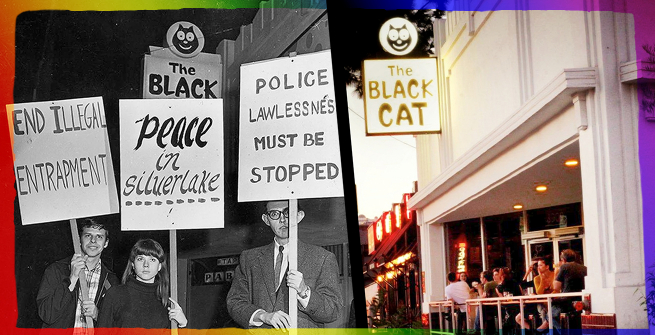Los Angeles has over 1,200 Historic-Cultural Monuments, yet only a dozen have been designated because of their association with the LGBTQIA community.
This post is part of a series we put together for Pride Month that tells the stories of historically and culturally significant LGBTQIA places across Los Angeles and the grassroots efforts to save them. You can also participate in the LGBTQIA Los Angeles Challenge to explore more landmarks and hidden gems that tell the story of L.A.’s diverse LGBTQIA heritage.
Part Three: The Black Cat
Two years before the famous Stonewall riots in New York City, undercover police officers raided the Black Cat as the clock struck midnight on New Year’s Eve 1966. The ensuing furor over police brutality and discrimination led to one of the first-ever documented LGBTQIA civil rights demonstrations.
On New Year’s Eve, 1966, the Black Cat had only been open a few months. The one-story Art Deco building was originally built as a Safeway grocery store but by the early sixties, it housed a gay bar and a laundromat. The Black Cat was one of a string of gay-friendly bars located on a stretch of Sunset Boulevard in Silver Lake.

The bar, still adorned with Christmas lights, was packed with revelers when the clock struck midnight. The Rhythm Queens broke into Auld Lang Syne as balloons dropped from the ceiling. Among the crowd were eight plainclothes policemen. As patrons exchanged celebratory hugs and kisses, the police started beating, handcuffing, and dragging people out onto the sidewalk. Fourteen people were arrested. Six were charged with lewd behavior for kissing a member of the same sex.
Activists responded to the police raid by organizing one of the earliest known protests in support of gay civil rights. They met in bars, handed out flyers, and used phone trees (you call ten people, they call ten other people, and so on) to get the word out.

On February 11, 1967, hundreds of people gathered outside the Black Cat. The peaceful gathering walked slowly up and down the street so the demonstrators could not be arrested for loitering.


The subsequent court case was legally significant. Two of the men were convicted of lewd behavior and forced to register as sex offenders. When they appealed their convictions in federal court, their attorney, Herbert E. Selwyn, did not deny his clients’ sexual orientation. Instead, he argued for their right to equal treatment under the law. This was the first time in U.S. history that gay men were defended in court as equal under the Constitution. The defendants lost the appeal, but this legal argument would come to be accepted decades later.
As is the case with all of the buildings in this series, it took the efforts of community activists and preservationists to identify and save this historically significant site. Local preservation advocate Wes Joe was active in the fight to designate the Black Cat a Los Angeles Historic-Cultural Monument.
“You can read about things in books and see videos, but having some place, you know, something about touching a building or seeing how it really looked, it can spur the imagination and it can deepen your understanding about the significance and hopefully, that’s what it does. People need to know where we came from”—Wes Joe
In the decades following the raid, the Black Cat went through numerous incarnations, including Basgo’s Disco and the gay Latino bar Le Barcito. In 2012, the renovated bar reopened as a gastropub using the original Black Cat name. A photo of the demonstration and a few other related items hang on the walls.
In 2008, the Black Cat was designated Los Angeles Historic-Cultural Monument #939, the first building to be designated solely for its significance in LGBTQIA history.

—With special thanks to Wes Joe for his help.
